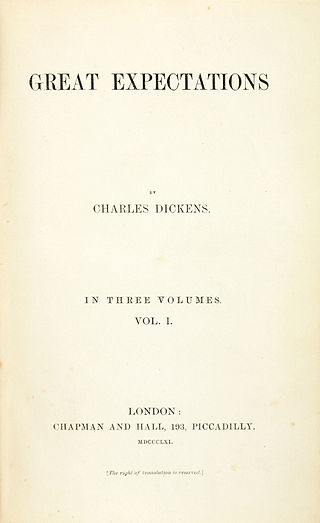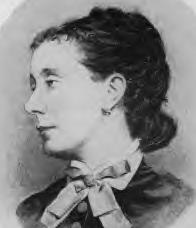Related Research Articles

Charles John Huffam Dickens was an English writer and social critic. He created some of the world's best-known fictional characters and is regarded by many as the greatest novelist of the Victorian era. His works enjoyed unprecedented popularity during his lifetime and, by the 20th century, critics and scholars had recognised him as a literary genius. His novels and short stories are widely read today.

Edward George Earle Lytton Bulwer-Lytton, 1st Baron Lytton, PC was an English writer and politician. He served as a Whig member of Parliament from 1831 to 1841 and a Conservative from 1851 to 1866. He was Secretary of State for the Colonies from June 1858 to June 1859, choosing Richard Clement Moody as founder of British Columbia. He declined the Crown of Greece in 1862 after King Otto abdicated. He was created Baron Lytton of Knebworth in 1866.

Great Expectations is the thirteenth novel by Charles Dickens and his penultimate completed novel. It depicts the education of an orphan nicknamed Pip. It is Dickens' second novel, after David Copperfield, to be fully narrated in the first person. The novel was first published as a serial in Dickens's weekly periodical All the Year Round, from 1 December 1860 to August 1861. In October 1861, Chapman and Hall published the novel in three volumes.

William Wilkie Collins was an English novelist and playwright known especially for The Woman in White (1859), a mystery novel and early "sensation novel", and for The Moonstone (1868), which, after Edgar Allan Poe's short story, Murders in the Rue Morgue, has been proposed as the first modern English detective novel.
This article contains information about the literary events and publications of 1842.

William Charles Macready was an English stage actor.

Douglas William Jerrold was an English dramatist and writer.

Edward Robert Lytton Bulwer-Lytton, 1st Earl of Lytton, was an English statesman, Conservative politician and poet who used the pseudonym Owen Meredith. He served as Viceroy of India between 1876 and 1880—during his tenure, Queen Victoria was proclaimed Empress of India—and as British Ambassador to France from 1887 to 1891.

All the Year Round was a Victorian periodical, being a British weekly literary magazine founded and owned by Charles Dickens, published between 1859 and 1895 throughout the United Kingdom. Edited by Dickens, it was the direct successor to his previous publication Household Words, abandoned due to differences with his former publisher.

The Cricket on the Hearth: A Fairy Tale of Home is a novella by Charles Dickens, published by Bradbury and Evans, and released 20 December 1845 with illustrations by Daniel Maclise, John Leech, Richard Doyle, Clarkson Stanfield and Edwin Henry Landseer. Dickens began writing the book around 17 October 1845 and finished it by 1 December. Like all of Dickens's Christmas books, it was published in book form, not as a serial.

Augustus Leopold Egg RA was a British Victorian artist, and member of The Clique best known for his modern triptych Past and Present (1858), which depicts the breakup of a middle-class Victorian family.

The Frozen Deep is an 1856 play, originally staged as an amateur theatrical, written by Wilkie Collins under the substantial guidance of Charles Dickens. Dickens's hand was so prominent—beside acting in the play for several performances, he added a preface, altered lines, and attended to most of the props and sets—that the principal edition of the play is entitled "Under the Management of Charles Dickens". John C. Eckel wrote: "As usual with a play which passed into rehearsal under Dickens' auspices it came out improved. This was the case with The Frozen Deep. The changes were so numerous that the drama almost may be ascribed to Dickens". Dickens himself took the part of Richard Wardour and was stage-manager during its modest original staging in Dickens's home Tavistock House. The play, however, grew in influence through a series of outside performances, including one before Queen Victoria at the Royal Gallery of Illustration, and a three-performance run at the Manchester Free Trade Hall for the benefit of the Douglas Jerrold Fund to benefit the widow of Dickens's old friend, Douglas Jerrold. There, night after night, everyone—including, by some accounts, the carpenters and the stage-hands—was moved to tears by the play. It also brought Dickens together with Ellen Ternan, an actress he hired to play one of the parts, and for whom he would later leave his wife Catherine. The play remained unpublished until a private printing appeared sometime in 1866.
The Newgate novels were novels published in England from the late 1820s until the 1840s that glamorised the lives of the criminals they portrayed. Most drew their inspiration from the Newgate Calendar, a biography of famous criminals published during the late 18th and early 19th centuries, and usually rearranged or embellished the original tale for melodramatic effect. The novels caused great controversy, and drew criticism in particular from the novelist William Makepeace Thackeray, who satirised them in several of his novels and attacked the authors openly.

Edward Bulwer Lytton Dickens was the youngest son of English novelist Charles Dickens and his wife Catherine. He emigrated to Australia at the age of 16, and eventually entered politics, serving as a member of the New South Wales Legislative Assembly from 1889 to 1894. He died in poverty at the age of 49.

Catherine Elizabeth Macready Perugini was an English painter of the Victorian era and the daughter of Catherine Dickens and Charles Dickens.

Georgina Hogarth was the sister-in-law, housekeeper, and adviser of English novelist Charles Dickens and the editor of three volumes of his collected letters after his death.

Mary "Mamie" Dickens was the eldest daughter of the English novelist Charles Dickens and his wife Catherine. She wrote a book of reminiscences about her father, and in conjunction with her aunt, Georgina Hogarth, she edited the first collection of his letters.

The Dickens family are the descendants of John Dickens, the father of the English novelist Charles Dickens. John Dickens was a clerk in the Royal Navy Pay Office and had eight children from his marriage to Elizabeth Barrow. Their second child and eldest son was Charles Dickens, whose descendants include the novelist Monica Dickens, the writer Lucinda Dickens Hawksley and the actors Harry Lloyd and Brian Forster.

Rosina Bulwer Lytton, Baroness Lytton, was an Anglo-Irish writer who published fourteen novels, a volume of essays and a volume of letters.

Edward Chapman was a British publisher who, with William Hall founded Chapman & Hall, publishers for Charles Dickens, William Thackeray, Robert Browning, Elizabeth Barrett Browning, Anthony Trollope, Eadweard Muybridge and Evelyn Waugh among others.
References
- ↑ "Edward Bulwer and Charles Dickens". Victorian Web. Retrieved 24 May 2013.
- ↑ "Queen Victoria's Journals". Princess Beatrice's copies. RA VIC/MAIN/QVJ (W). 4 July 1857. Retrieved 24 May 2013.
